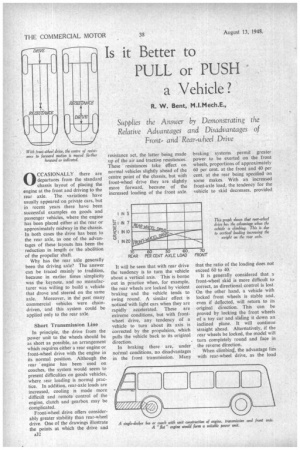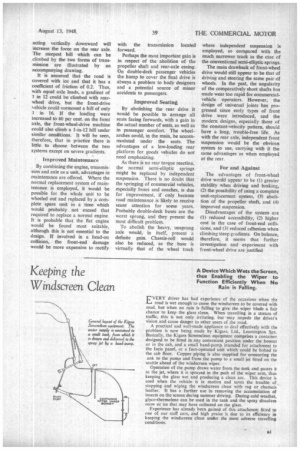s it Better to PULL or PUSH a Vehicle ?
Page 34

Page 35

If you've noticed an error in this article please click here to report it so we can fix it.
R. W. Bent, M.I.Mech.E.,
Supplies the Ammer by Demonstrating the Relative Advantages and Disadvantages of Frontand Drive OCCASIONALLY there are departures from the standard chassis layout of placing the engine at the front and driving to the rear axle. The variations have usually appeared on private cars, but in recent years there have been successful examples on goods and passenger vehicles, where the engine has been placed either at the rear or approximately midway in the chassis. In both cases the drive has been to the rear axle, as one of the advantages of these layouts has been the reduction in length or the abolition of the propeller shaft.
Why has the rear axle generally been the driving axle? The answer can be traced mainly to tradition, because in earlier times simplicity was the keynote, and no manufacturer was willing to build a vehicle that drove and steered on the same axle. Moreover, in the past many commercial vehicles were chaindriven, and this system could be applied only to the rear axle.
Short Transmission Line
In principle, the drive from the power unit to the wheels should be as short as possible, an arrangement which requires either a rear engine or front-wheel drive with the engine in its normal position. Although the rear engine has been used on coaches, the system would seem to present difficulties on goods vehicles, where fear loading is normal practice. In addition, rear-axle loads are increased, cooling is made more difficult and remote control of the engine, clutch and gearbox may be complicated.
Front-wheel drive offers considerably greater stability than rear-wheel drive, One of the drawings illustrate the points at which the drive and 1.32 resistance act, the latter being made up of the air and tractive resistances. These resistances take effect on normal vehicles slightly ahead of the centre point of the chassis, but with front-wheel drive they are slightly more forward, because of the increased loading of the front axle.
It will be seen that with rear drive the tendency is to turn the vehicle about a vertical axis. This is borne out in practice when, for example, the rear wheels are locked by violent braking and the vehicle tends to swing round. A similar effect is noticed with light cars when they are rapidly accelerated. These are extreme conditions, but with frontwheel drive, any tendency of a vehicle to turn about its axis is corrected by the propulsion, which pulls the vehicle back to its original direction.
In braking there are, under noimal conditions, no disadvantages in the front transmission. Many braking systems permit greater power to be exerted on the front wheels, proportions of approximately 60 per cent, at the front and 40 per cent, at the rear being specified on some makes. With an increased front-axle load, the tendency for the vehicle to skid decreases, provided that the ratio of the loading does not exceed 60 to 40.
It is generally considered that a front-wheel skid is more difficult to correct, as directional control is lost. On the other hand, a vehicle with locked front wheels is stable and, even if deflected, will return to its original direction. This can be proved by locking the front wheels of a toy car and sliding it down an inclined plane. It will continue straight ahead. Alternatively, if the rear wheels be locked, the model will turn completely round and face in the reverse direction.
When climbing, the advantage lies with rear-wheel drive, as the load acting vertically downward will increase the force on the rear axle_ The steepest hill which can be climbed by the two forms of transmission are illustrated by an accompanying drawing.
It is assumed that the road is covered with ice and that it has a coefficient of friction of 0.2. Thus, with equal axle loads, a gradient of 1 in 12 could be climbed with rearwheel drive, but the front-drive chicle could surmount a hill of only 1 in 16. if the loading were increased to 60 per cent. on the front axle, the front-wheel-drive machine could also climb a 1-in-12 hill under similar conditions. It will be seen, therefore, that in practice there is little to choose between the two systems except on severe gradients.
Improved Maintenance By combining the engine, transmission and axle as a unit, advantages in maintenance are offered. Where the normal replacement system of maintenance is employed, it would be possible for the whole unit to be wheeled out and replaced by a complete spare unit in a time which would probably not exceed that required to replace a normal engine. It is probable that the flat engine would be found most suitable, although this is not essential to the design. If involved in a head-on collision, the front-end damage would be more expensive to rectify with the transmission located forward.
Perhaps the most important gain is in respect of the abolition of the propeller shaft and rear-axle casing. On double-deck passenger vehicles the hump to cover the final drive is always a problem to body designers and a potential source of minor accidents to passengers.
Improved Seating By abolishing the rear drive it would be possible to arrange all seats facing forwards, with a gain in the actual number of seats, as well as in passenger comfort. The wheelarches could, in the main, be accommodated under the seats. The advantages of a low-loading rear platform for goods vehicles do not need emphasizing.
As there is no rear torque reaction, the normal semi-elliptic springs might be replaced by independent suspension. There is no doubt that the springing of commercial vehicles, especially buses and coaches, is due for improvement, if only because road maintenance is likely to receive scant attention for some years. Probably double-deck buses are the worst sprung, and they present the most difficult problem.
To abolish the heavy, unsprung axle would, in itself, present a definite gain. Chassis-roll would also be reduced, as the base is virtually that of the wheel track where independent suspension is employed, as compared with the much narrower track in the case of the conventional semi-elliptic springs.
The main drawback of front-wheel drive would still appear to be that of driving and steering the same pair of wheels. In the past, the angularity of the comparatively short shafts has made wear too rapid for commercialvehicle operators. However, the design of universal joints has progressed since early types of front drive were introduced, and the modern designs, especially those of the constant-velocity pattern, should have a long, trouble-free life. As with the rear axle, independent front suspension would be the obvious system to use, carrying with it the same advantages as when employed at the rear.
For and Against
The advantages of front-wheel drive would appear to be (1) greater stability when driving and braking, (2) the possibility of using a complete unit-replacement system, (3) abolition of the propeller shaft, and (4) improved suspension.
Disadvantages of the system are (1) reduced accessibility, (2) higher cost in the case of front-end collisions, and (3) reduced adhesion when climbing steep gradients. On balance, therefore, it seems that further investigation and experiment with front-wheel drive are justified












































































